Table of Contents
In this article, we will learn about the Habitat, structure, nutrition, characteristics, reproduction, locomotion of the Amoeba cell with diagram.
| Domain | Eukaryota |
| Phylum | Amoebozoa |
| Class | Tubulinea |
| Order | Euamoebida |
| Family | Amoebidae |
| Genus | Amoeba |
Amoeba cell also known as the ameba or amoeboid. Amoeba is a unicellular eukaryotic organism which can alter their shape by extending and retracting pseudopods.
The term Amoeba came from the Greek word amoibe, means change. They do not contain any cell wall instead they contain a thin delicate outer membrane known as the plasmalemma.
Habitat of Amoeba Cell
The Amoeba cells can be found in everywhere. They can be found at the bottom of pools, ponds, ditches, lakes, and slow streams. Sometimes they are found in association with aquatic vegetation.
Mainly they are found in those waters containing bacteria and organic substances, such as leaves, twigs, and other aquatic vegetation in abundance.
Culture Preparation of Amoeba Cell
To prepare a culture of amoebae cell –
- Take 100ml of water with a few grains of wheat.
- Then put some pond water, mud, and leaves in this 100ml water.
- After a few days, the amoebae will appear on water. This indicates the presence of cysts in the pond water.
- To prepare a pure culture of amoeba cell, take 4 – 5 grains of wheat in 100 ml of distilled water and then boil it for 10 minutes. After that kept it for a few days.
- Then add some Amoebae from the previous culture and cover with a glass plate.
- Amoeba cells will be formed in the pure culture within 10days.
Amoeba Characteristics
- They are one-celled microscopic animals.
- They are transparent and are invisible to the naked eyes.
- They don’t contain cell walls.
- Their size is about 0.25 mm.
- Under a compound microscope, they appear as an irregular, colorless, translucent mass of living jelly-like animals or protoplasm which constantly changes its shape by sending out and withdrawing finger-like processes, the pseudopodia.
- They contain a finger-like projection known as pseudopodia, which helps them in locomotion.
- The cytoplasm is divided into two portions, the outer portion and the inner portion. The outer portion is known as the ectoplast, whereas the inner portion is known as the endoplast.
- They are eukaryotic organisms found in stagnant water.
- They contain a cell membrane, it encloses the cytoplasm and cellular contents.
- Their DNA is packed into the nucleus.
- They contain food vacuoles, a granular nucleus, and a clear contractile vacuole.
- During the splitting, the nucleus containing a portion is formed a new cell whereas the other portion eventually dies.
- Under unfavorable conditions, amoeba creates a protective covering and waits until the condition becomes normal.
- They reproduce by binary fission.
- They can distinguish food from other materials.
- They secrete digestive enzymes in food vacuoles to digest the food.
- Amoeba can change their shape during the movement.
- They engulf the food particles by pseudopodia, forming food vacuoles.
Structure of Amoeba Cell with Diagram
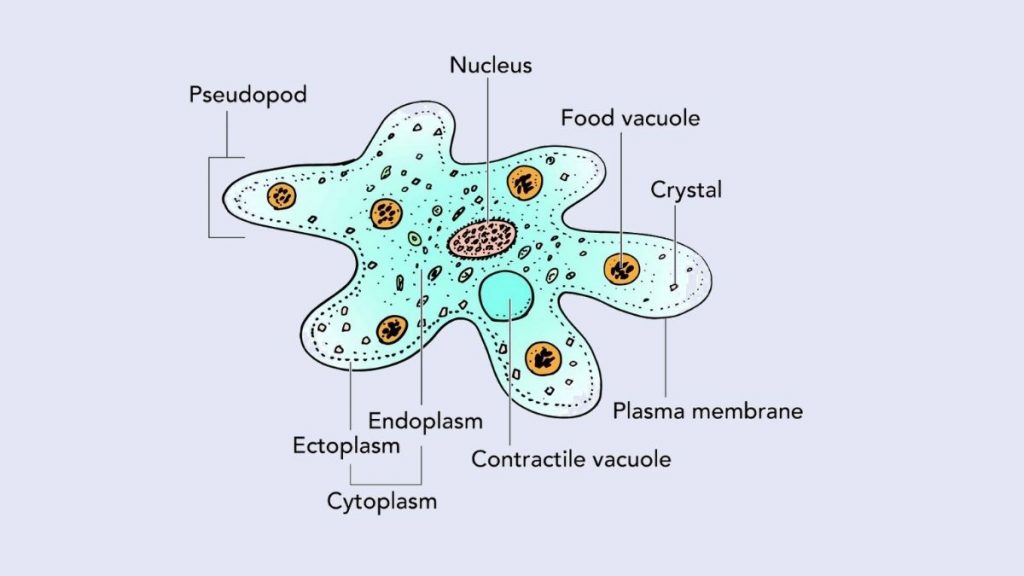
(i) Pseudopodia
- These are the finger-like, cylindrical, blunt-ended extensions from the cytoplasm which help in locomotion of amoeba.
- During the locomotion, these are constantly being given out or withdrawn by the body.
- They are also known as lobopodia.
- They are made of both ectoplasm and endoplasm.
- The liquefaction and flowing forward of the cytoplasm is responsible for the formation of pseudopodia.
(ii) Plasmalemma
- This is a thin, delicate, invisible, elastic external cell membrane
- The thickness ranges from 0.00025 mm to 2 microns.
- The Plasmalemma is made of protein molecules and a double layer of lipid.
- The mucoproteins are attached to the outer surface of the plasmalemma.
- Plasmalemma has the capability to regenerate itself when broken.
- It is selectively permeable and can exchange water, O2, and CO2 from the surrounding medium.
- It helps in the formation of pseudopodia and food capture.
(iii) Cytoplasm
- The Plasmalemma surrounded a dense mass known as cytoplasm.
- It contains different organelles.
- The cytoplasm is divided into two parts such as outer ectoplasm and an inner endoplasm.
Ectoplasm
A thin, clear (non-granular) and hyaline layer is located beneath the plasmalemma, known as the Ectoplasm. It contains a number of conspicuous longitudinal ridges, for this it functions as a supporting layer.
Endoplasm
Endoplasm is a granular heterogeneous fluid surrounded by the ectoplasm. Endoplasm contains a number of organelles such as the nucleus, contractile vacuole, food vacuoles, mitochondria, Golgi apparatus, fat globules, and plate-like or bi-pyramidal crystals.
(iv) Endoplasmic Organelles
(a) Nucleus
- It contains a single conspicuous nucleus.
- In young specimens, the nucleus appears as a biconcave disc. In older specimens, it is folded and convoluted.
- The nucleus is surrounded by a nuclear membrane or nuclear envelope and the chromidia distributed uniformly near the surface.
- It has a smaller nucleoplasm, that is why it is called a massive or granular nucleus.
- It contains over 500 small spherical chromosomes.
(b) Contractile Vacuole
- Contractile Vacuole is a clear, rounded, and pulsating vacuole filled with a watery fluid. It is covered with a unit membrane.
- The Contractile Vacuole is located at the outer part of the endoplasm near the posterior end.
- It circulates within the endoplasm.
- It gradually increases its size by fusing a number of smaller vacuoles and ultimately bursts.
- It helps in the removal of water which is absorbed by the Amoeba and also removes the CO2 and waste substances. Thus it maintains the tension between the protoplasm and the surrounding water.
- Some marine and parasitic amoebae possess no contractile vacuole because the osmotic pressure of their protoplasm is about the same as that of the surrounding medium.
- Contractile Vacuole helps in osmoregulation, respiration, and excretion.
(c) Food Vacuoles
- Food Vacuoles are non-contractile organelles of different sizes. They remain scattered in the endoplasm.
- Their location is not fixed, they moved with the movements of the endoplasm.
- Food vacuole helps in the digestion of food particles by secreting different digestive enzymes.
(d) Water Globules or globule
- Water Globules are small in size, spherical, colorless, and non-contractile vacuoles.
- They are filled with water.
- They maintain the water balance of the body.
(e) Stored food
They contain Numerous fats and carbohydrates as granules and are recognized by special stains.
(f) Mitochondria
Mitochondria are present within the amoeba in the form of rods or dots.
(g) Crystals
These are metabolic wastes of assorted sizes and shapes.
Locomotion/Movement of Amoeba Cell
- The amoeba movement is creeping in nature. They move by the formation of finger-like projections known as pseudopodia.
- Amoeba Cell moves by forming one or more blunt-ended finger-like pseudopodia at the direction of movement. They continuously accumulate the cytoplasm from other parts of the body so that the projection grows more and more.
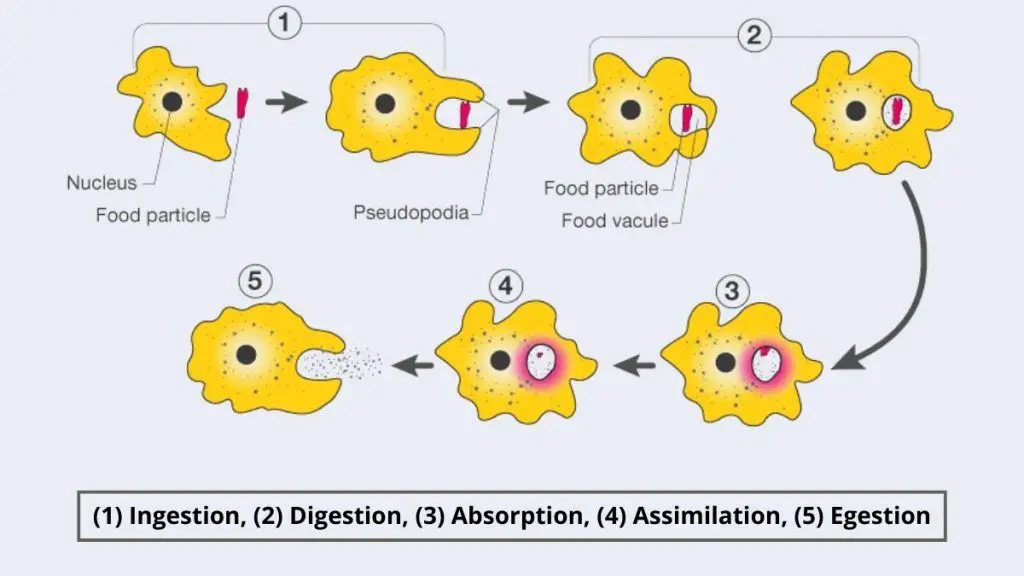
Formation of Pseudopodia
- There is a theory about the formation of pseudopodia in the amoeba cell which was given by the Mast. He divides the amoeba cell into four parts such as the thin and elastic plasma membrane, the plasma gel, the plasmasol, and a hyaline fluid which is located between the membrane and plasma gel.
- The Actions and interactions between these four parts are responsible for the formation of pseudopodia.
- At first, the plasma membrane attached to the substratum, then liquefaction occurs in the plasma gel. A new bulge is produced when the plasma gel exerts pressure (osmotic and other forces) on the weakened area.
- The plasma gel started to convert verts into plasmasol. The gelation of plasmasol occurs which results in continuous regeneration of the plasmagel tube and the pseudopodium grows.
- The spontaneous and reversible sol-gel phenomenon is responsible for the formation of pseudopodia and the resultant movement in amoeba.
Nutrition in Amoeba
- Amoeba can not produce their food. They ingest ready-made organic substances as a food. This type of nutrition is known as zoo trophic or holozoic.
- The food material of amoena cells can be algal cells and filaments, bacteria, other protozoans, small metazoans such as rotifers and nematodes and organic matter. Smaller flagellates and ciliates are considered as the favourite food of amoeba.
- The mode of nutrition in amoeba is accomplished in several steps such as ingestion, digestion, assimilation, dissimilation and egestion.
(i) Ingestion
- They intake the food material by phagocytosis. They don’t have any dedicated entry point for food intake so they engulf the food materials by the formation of a food cup.
- They chase their food from a considerable distance. When they come in contact with the foods, they start to extend their pseudopodia around the food particles and form a concavity or food-cup.
- The two ends of pseudopodia meet and fuse, finally a vacuole is formed with food particles and some amount of water.
(ii) Digestion
- In this process involves the conversation of insoluble and large food molecules into soluble and minute molecules.
- The digestion process within the food vacuoles is started with the secretion of HCL. Which kills the living foods and makes the medium acidic but later it becomes alkaline.
- After that protoplasm secrets different enzymes inside the food cup, such as proteases (protein-splitting enzymes), amylases (starch-digesting enzymes) and lipases (fat-splitting enzymes). These enzymes convert the proteins into amino acids; starch into soluble sugar; and fats into fatty acids and glycerol.
(iii) Absorption
- In this method the nutrients are absorbed into the cell cytoplasm by the diffusion.
- They store the excess foods as a glycogen and lipids.
(iv) Assimilation
- In this method the cell absorbs energy from the absorbed food molecules to carry out different life processes.
- The protoplasm absorbs the digested food, water and minerals by the diffusion. They get assimilated to build new protoplasm whereas the sugar, fatty acids and glycerol provide energy.
(v) Dissimilation
- It involves the breakdown of complex molecules within the protoplasm and produces energy to perform different activities within the cell.
- The oxidation breaks the living protoplasm and produces heat, kinetic energy and waste products.
(vi) Egestion
- It involves the excretion of undigested food material from the amoeba cell.
- They throw the non-digested food material through temporary openings in the ectoplasm at a spot near the food vacuole.
- The excretion of undigested food material can occur at any point on the surface through no special opening.
Amoeba Reproduction
Amoeba reproduce by asexually. The axeual reproduction of amoeba is accomplished by three distinct methods such as binary fission, multiple fission and sporulation.
(i) Binary Fission
The amoeba first replicates its genetic material by mitotic division. After completion of nucleus division it divides the cytoplasm at the center of the cell and separates, and forms two equal-sized daughter cells. These two newly formed cells are the identical clones of the parent cell.
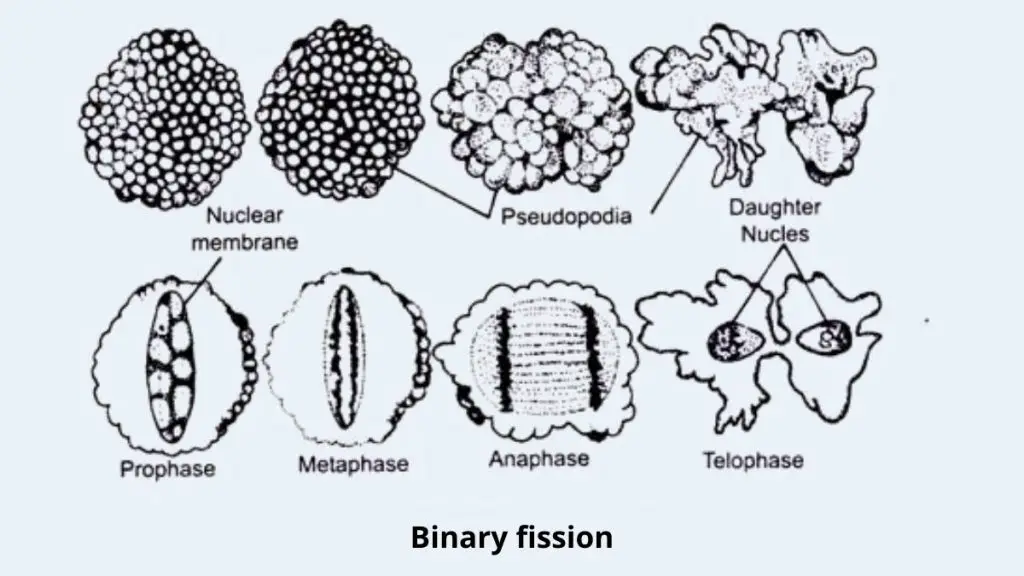
(ii) Multiple Fission and Encystment
During unfavourable conditions amoeba undergoes through the Multiple Fission and produces multiple cells.
- At first they withdraw the Pseudopodia and the cell becomes rounded, streaming movements of endoplasm cease, larger granules dissolve and protoplasm becomes minutely granular, distinction between ectoplasm and endoplasm is lost.
- Then amoeba develops cyst around it to protect the cell.
- The cell undergoes mitosis several times and produces multiple daughter cells.
- Under favorable conditions the cyst wall absorbs water and bursts and releases the daughter cells within the host cell.
- The amoeba cell will undergo the encystment process as a means of protection against desiccation as it travels through the colon, which ensures its survival outside of the host.
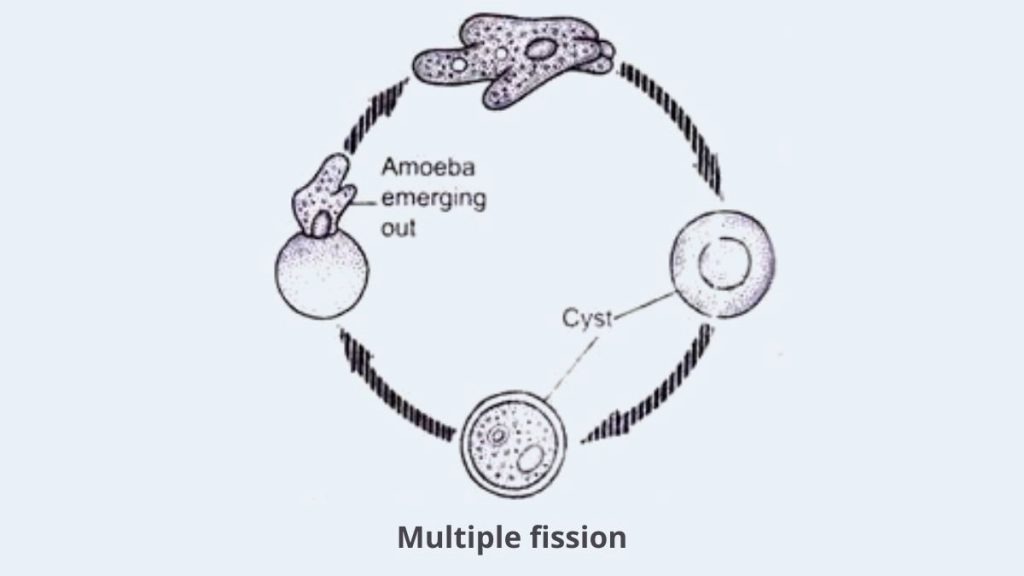
(iii) Sporulation
Under unfavorable conditions the amoeba cell reproduces by the Sporulation. At first the nuclear membrane ruptures and releases chromatin blocks into the cytoplasm.
Then each chromatin develops a nuclear membrane to form a new daughter nucleus. After that the cytoplasm is developed around each nuclei to form an amoeba. Then the spore case is developed around the amoeba to form a spore. Around 200 spores are developed.
After that the parent body bursts and releases the spores, at the beginning the spores remain in a dormant stage. When the favourable conditions return each spore develops a new daughter cell.
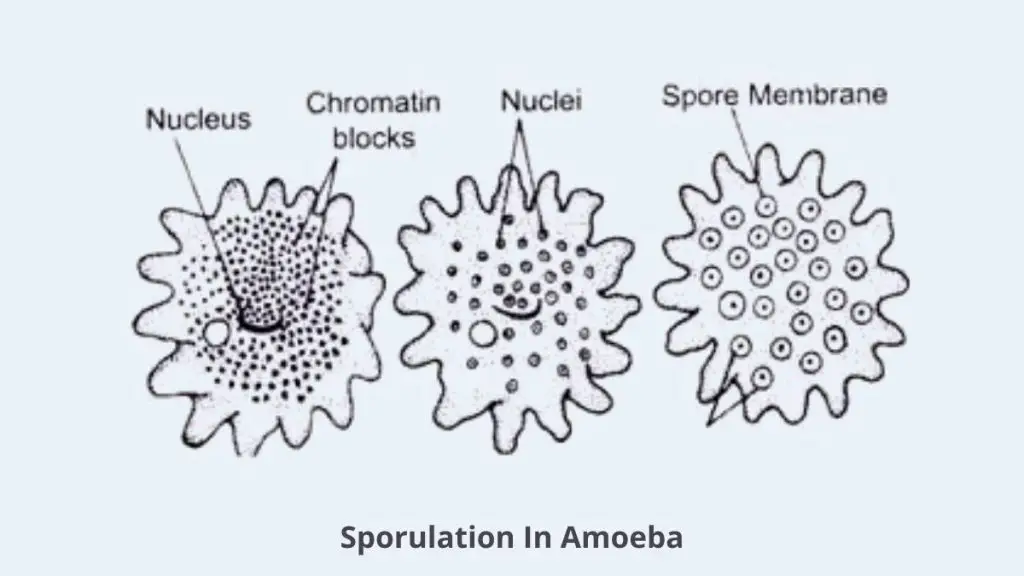
Respiration of Amoeba Cell
- Amoeba needs oxygen to burn the stored food materials so that they can produce energy for the locomotion.
- They get the dissolved air from the surrounding water into their cytoplasm through the plasma lemma.
- The carbon dioxide produced by oxidation is stored as bubbles in the contractile vacuole. Later this co2 released from the body through the diffusion.
Excretion of Amoeba
The amoeba produces nitrogenous waste products within the cell during its metabolic activity. These metabolic waste products also contain the water stored within the contractile vacuole.
Later these vacuoles burst and release their contents into the surrounding water. Again a new contractile vacuole is formed in its original position.
Regeneration of Amoeba
Amoeba has a capability to regenerate itself. If an amoeba is cut into small pieces, each piece can regenerate into a new amoeba, however, a piece without a nuclear fragment does not regenerate.
Taxes of Amoeba
The responses to stimuli are known as taxes. There are two types of taxes based on the direction of movement such as positive and negative taxes.
If the cell moves towards the stimulus is known as positive taxes. If the cell moves away from the stimulus is known as negative taxes.
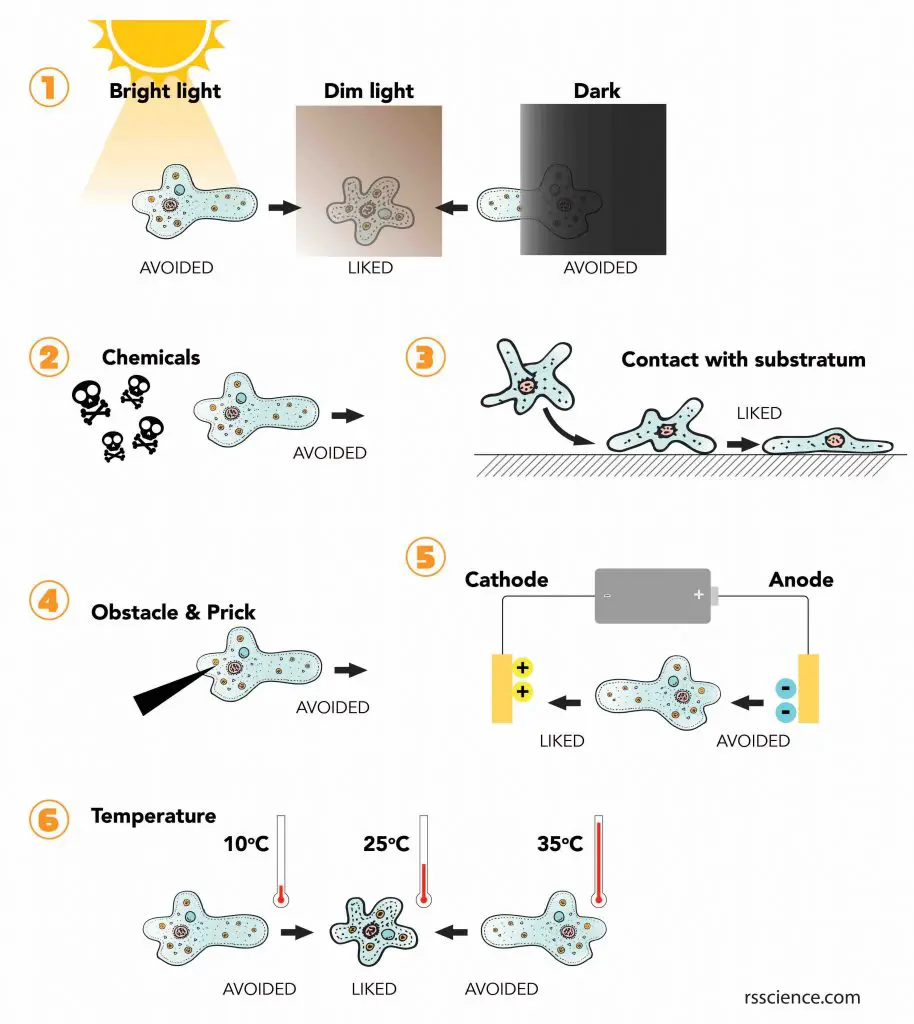
The Amoeba cell responds to different types of stimuli, based on the types of stimuli the taxes of amoeba is classified as follows:
(i) Thigmotaxis (response to contact or touch), On contact or touch amoeboid shows different responses. When amoeba touches a solid object it shows a negative response. The floating Amoeba shows a positive response when it contacts the solid object. Contact with the food also shows a positive response.
(ii) Chaemotaxis (response to chemicals), Amoeba shows negative responses when they come in contact with chemicals.
(iii) Thermotaxis (response to heat), amoeba shows negative response when it contacts with heat.
(iv) Phototaxis (response to light), they move away from strong light and react positively to weak light.
(v) Galvanotaxis (response to electric current), it stops moving when electric current is passed through the water. In presence of weak electric current amoeba moves towards the negative pole (cathode) and, thus, avoids positive pole (anode).
(vi) Rheotaxis (response to water current), they exhibit positive rheotaxis as it tends to move in line with the water current.
(vii) Geotaxis (response to gravity), It shows positive geotaxis since it moves toward the centre of gravity.
Amoeba Disease
- The protozoa Entamoeba histolytica, or E. histolytica causes an intestine infection known as Amebiasis.
- Those persons who have traveled to tropical locations or immigrants from tropical countries or people who live in institutions with poor sanitary conditions are at great risk for amebiasis.
- The symptoms of this disease are loose stool, abdominal cramping, and stomach pain.
- The diagnosis of Amebiasis can be done by ultrasound or CT scan to check for lesions on your liver.
- Amoebiasis is transmitted through the fecal-oral route. Sometimes they can be transmitted indirectly through contact with dirty hands.
- This infection can be treated with a 10-day course of metronidazole (Flagyl) that you take as a capsule.
- To prevent the amebiasis always wash fruits and vegetables before eating and also peel them yourself; Avoid milk, cheese, or other unpasteurized dairy products and also ice cubes or fountain drinks; drink bottled water or properly boiled water; don’t eat foods from the street vendors.

This was super helpful, contains more information than I asked for
Thank You Nicole